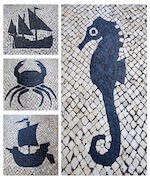
Résumé
S’appuyant sur un travail de terrain, cet article examine les manières dont la calçada portuguesa (le pavé portugais) que l’administration portugaise a développé à Macao (Chine), a été convertie en « élément culturel » de l’identité visuelle et urbaine de la ville. L’article montre comment un projet quelque peu lié à la fin de l’ère coloniale occupe de l’espace à travers une opération de renouvellement urbain contesté par les habitants, transformant la calçada dans un récit spatial et historique finalement accepté. Cette stratégie étant désormais liée à la production du patrimoine et à l’émergence d’une plus forte « thématisation » dans la promotion de Macao comme ville de tourisme.
Déployée dans la revitalisation du paysage de la ville (« cityscape »), la calçada s’est heurtée à l’animosité et à une résistance de la part de la population chinoise. L’image et héritage contestés du départ ont toutefois fait l’objet d’une régénération symbolique grâce au tournant discursif et matériel qu’a subi la calçada lorsqu’elle a gagné des traits plus « locaux » intégrant l’histoire culturelle de la ville. À travers ce processus, le passé et le présent se sont combinés dans une fabrication nouvelle qui a fini par affaiblir les tensions qui marquent les relations inter-ethniques lors de la transition du colonial vers le postcolonial à Macao.
Summary
Drawing on ethnographic research, this article examines the ways in which the calçada portuguesa (“Portuguese pavement”) that the late Portuguese administration developed in Macau (China) was converted into a “cultural item” of Macau’s visual and urban identity. It shows how a project loosely linked to the demise of the colonial, while reclaiming space through a contested operation of urban renewal, transformed the calçada into a seemingly desired spatial and historical narrative, tied to the production of heritage and the emergence of a stronger “theming” strategy of tourism promotion for Macau. Primarily an urban project employed in the revitalization of the cityscape, the incipient calçada encountered culturally inspired resistance and animosity from the Chinese population. At first embodying a contested image and legacy, the pavement has, nevertheless, undergone symbolic regeneration through discursive and material readjustment following its localization into the cultural history of place. Throughout this process, past and present were conflated in a fabrication that eventually undermined the reminiscent equivocal nature of interethnic relations that marked the transition from colonial to postcolonial Macau.

